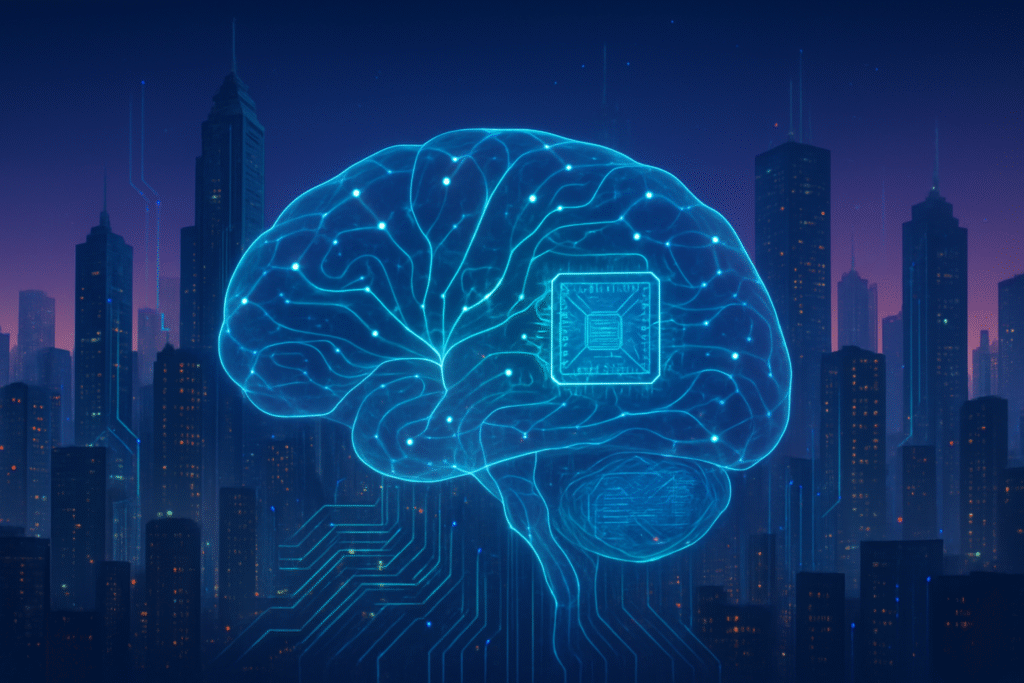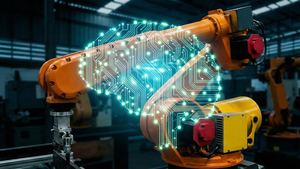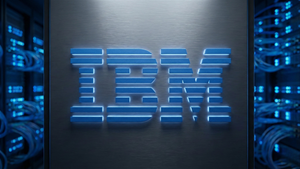
In an era defined by rapid technological advancement, the relationship between Artificial Intelligence (AI) and semiconductor development has emerged as a quintessential example of a symbiotic partnership, driving what many industry observers now refer to as an "AI Supercycle." This profound interplay sees AI's insatiable demand for computational power pushing the boundaries of chip design, while breakthroughs in semiconductor technology simultaneously unlock unprecedented capabilities for AI, creating a virtuous cycle of innovation that is reshaping industries worldwide. From the massive data centers powering generative AI models to the intelligent edge devices enabling real-time processing, the relentless pursuit of more powerful, efficient, and specialized silicon is directly fueled by AI's growing appetite.
This mutually beneficial dynamic is not merely an incremental evolution but a foundational shift, elevating the strategic importance of semiconductors to the forefront of global technological competition. As AI models become increasingly complex and pervasive, their performance is inextricably linked to the underlying hardware. Conversely, without cutting-edge chips, the most ambitious AI visions would remain theoretical. This deep interdependence underscores the immediate significance of this relationship, as advancements in one field invariably accelerate progress in the other, promising a future of increasingly intelligent systems powered by ever more sophisticated silicon.
The Engine Room: Specialized Silicon Powers AI's Next Frontier
The relentless march of deep learning and generative AI has ushered in a new era of computational demands, fundamentally reshaping the semiconductor landscape. Unlike traditional software, AI models, particularly large language models (LLMs) and complex neural networks, thrive on massive parallelism, high memory bandwidth, and efficient data flow—requirements that general-purpose processors struggle to meet. This has spurred an intense focus on specialized AI hardware, designed from the ground up to accelerate these unique workloads.
At the forefront of this revolution are Graphics Processing Units (GPUs), Application-Specific Integrated Circuits (ASICs), and Neural Processing Units (NPUs). Companies like NVIDIA (NASDAQ: NVDA) have transformed GPUs, originally for graphics rendering, into powerful parallel processing engines. The NVIDIA H100 Tensor Core GPU, for instance, launched in October 2022, boasts 80 billion transistors on a 5nm process. It features an astounding 14,592 CUDA cores and 640 4th-generation Tensor Cores, delivering up to 3,958 TFLOPS (FP8 Tensor Core with sparsity). Its 80 GB of HBM3 memory provides a staggering 3.35 TB/s bandwidth, essential for handling the colossal datasets and parameters of modern AI. Critically, its NVLink Switch System allows for connecting up to 256 H100 GPUs, enabling exascale AI workloads.
Beyond GPUs, ASICs like Google's (NASDAQ: GOOGL) Tensor Processing Units (TPUs) exemplify custom-designed efficiency. Optimized specifically for machine learning, TPUs leverage a systolic array architecture for massive parallel matrix multiplications. The Google TPU v5p offers ~459 TFLOPS and 95 GB of HBM with ~2.8 TB/s bandwidth, scaling up to 8,960 chips in a pod. The recently announced Google TPU Trillium further pushes boundaries, promising 4,614 TFLOPs peak compute per chip, 192 GB of HBM, and a remarkable 2x performance per watt over its predecessor, with pods scaling to 9,216 liquid-cooled chips. Meanwhile, companies like Cerebras Systems are pioneering Wafer-Scale Engines (WSEs), monolithic chips designed to eliminate inter-chip communication bottlenecks. The Cerebras WSE-3, built on TSMC’s (NYSE: TSM) 5nm process, features 4 trillion transistors, 900,000 AI-optimized cores, and 125 petaflops of peak AI performance, with a die 57 times larger than NVIDIA's H100. For edge devices, NPUs are integrated into SoCs, enabling energy-efficient, real-time AI inference for tasks like facial recognition in smartphones and autonomous vehicle processing.
These specialized chips represent a significant divergence from general-purpose CPUs. While CPUs excel at sequential processing with a few powerful cores, AI accelerators employ thousands of smaller, specialized cores for parallel operations. They prioritize high memory bandwidth and specialized memory hierarchies over broad instruction sets, often operating at lower precision (16-bit or 8-bit) to maximize efficiency without sacrificing accuracy. The AI research community and industry experts have largely welcomed these developments, viewing them as critical enablers for new forms of AI previously deemed computationally infeasible. They highlight unprecedented performance gains, improved energy efficiency, and the potential for greater AI accessibility through cloud-based accelerator services. The consensus is clear: the future of AI is intrinsically linked to the continued innovation in highly specialized, parallel, and energy-efficient silicon.
Reshaping the Tech Landscape: Winners, Challengers, and Strategic Shifts
The symbiotic relationship between AI and semiconductor development is not merely an engineering marvel; it's a powerful economic engine reshaping the competitive landscape for AI companies, tech giants, and startups alike. With the global market for AI chips projected to soar past $150 billion in 2025 and potentially reach $400 billion by 2027, the stakes are astronomically high, driving unprecedented investment and strategic maneuvering.
At the forefront of this boom are the companies specializing in AI chip design and manufacturing. NVIDIA (NASDAQ: NVDA) remains a dominant force, with its GPUs being the de facto standard for AI training. Its "AI factories" strategy, integrating hardware and AI development, further solidifies its market leadership. However, its dominance is increasingly challenged by competitors and customers. Advanced Micro Devices (NASDAQ: AMD) is aggressively expanding its AI accelerator offerings, like the Instinct MI350 series, and bolstering its software stack (ROCm) to compete more effectively. Intel (NASDAQ: INTC), while playing catch-up in the discrete GPU space, is leveraging its CPU market leadership and developing its own AI-focused chips, including the Gaudi accelerators. Crucially, Taiwan Semiconductor Manufacturing Company (NYSE: TSM), as the world's leading foundry, is indispensable, manufacturing cutting-edge AI chips for nearly all major players. Its advancements in smaller process nodes (3nm, 2nm) and advanced packaging technologies like CoWoS are critical enablers for the next generation of AI hardware.
Perhaps the most significant competitive shift comes from the hyperscale tech giants. Companies like Google (NASDAQ: GOOGL), Amazon (NASDAQ: AMZN), Microsoft (NASDAQ: MSFT), and Meta Platforms (NASDAQ: META) are pouring billions into designing their own custom AI silicon—Google's TPUs, Amazon's Trainium, Microsoft's Maia 100, and Meta's MTIA/Artemis. This vertical integration strategy aims to reduce dependency on third-party suppliers, optimize performance for their specific cloud services and AI workloads, and gain greater control over their entire AI stack. This move not only optimizes costs but also provides a strategic advantage in a highly competitive cloud AI market. For startups, the landscape is mixed; while new chip export restrictions can disproportionately affect smaller AI firms, opportunities abound in niche hardware, optimized AI software, and innovative approaches to chip design, often leveraging AI itself in the design process.
The implications for existing products and services are profound. The rapid innovation cycles in AI hardware translate into faster enhancements for AI-driven features, but also quicker obsolescence for those unable to adapt. New AI-powered applications, previously computationally infeasible, are now emerging, creating entirely new markets and disrupting traditional offerings. The shift towards edge AI, powered by energy-efficient NPUs, allows real-time processing on devices, potentially disrupting cloud-centric models for certain applications and enabling pervasive AI integration in everything from autonomous vehicles to wearables. This dynamic environment underscores that in the AI era, technological leadership is increasingly intertwined with the mastery of semiconductor innovation, making strategic investments in chip design, manufacturing, and supply chain resilience paramount for long-term success.
A New Global Imperative: Broad Impacts and Emerging Concerns
The profound symbiosis between AI and semiconductor development has transcended mere technological advancement, evolving into a new global imperative with far-reaching societal, economic, and geopolitical consequences. This "AI Supercycle" is not just about faster computers; it's about redefining the very fabric of our technological future and, by extension, our world.
This intricate dance between AI and silicon fits squarely into the broader AI landscape as its central driving force. The insatiable computational appetite of generative AI and large language models is the primary catalyst for the demand for specialized, high-performance chips. Concurrently, breakthroughs in semiconductor technology are critical for expanding AI to the "edge," enabling real-time, low-power processing in everything from autonomous vehicles and IoT sensors to personal devices. Furthermore, AI itself has become an indispensable tool in the design and manufacturing of these advanced chips, optimizing layouts, accelerating design cycles, and enhancing production efficiency. This self-referential loop—AI designing the chips that power AI—marks a fundamental shift from previous AI milestones, where semiconductors were merely enablers. Now, AI is a co-creator of its own hardware destiny.
Economically, this synergy is fueling unprecedented growth. The global semiconductor market is projected to reach $1.3 trillion by 2030, with generative AI alone contributing an additional $300 billion. Companies like NVIDIA (NASDAQ: NVDA), Advanced Micro Devices (NASDAQ: AMD), and Intel (NASDAQ: INTC) are experiencing soaring demand, while the entire supply chain, from wafer fabrication to advanced packaging, is undergoing massive investment and transformation. Societally, this translates into transformative applications across healthcare, smart cities, climate modeling, and scientific research, making AI an increasingly pervasive force in daily life. However, this revolution also carries significant weight in geopolitical arenas. Control over advanced semiconductors is now a linchpin of national security and economic power, leading to intense competition, particularly between the United States and China. Export controls and increased scrutiny of investments highlight the strategic importance of this technology, fueling a global race for semiconductor self-sufficiency and diversifying highly concentrated supply chains.
Despite its immense potential, the AI-semiconductor symbiosis raises critical concerns. The most pressing is the escalating power consumption of AI. AI data centers already consume a significant portion of global electricity, with projections indicating a substantial increase. A single ChatGPT query, for instance, consumes roughly ten times more electricity than a standard Google search, straining energy grids and raising environmental alarms given the reliance on carbon-intensive energy sources and substantial water usage for cooling. Supply chain vulnerabilities, stemming from the geographic concentration of advanced chip manufacturing (over 90% in Taiwan) and reliance on rare materials, also pose significant risks. Ethical concerns abound, including the potential for AI-designed chips to embed biases from their training data, the challenge of human oversight and accountability in increasingly complex AI systems, and novel security vulnerabilities. This era represents a shift from theoretical AI to pervasive, practical intelligence, driven by an exponential feedback loop between hardware and software. It's a leap from AI being enabled by chips to AI actively co-creating its own future, with profound implications that demand careful navigation and strategic foresight.
The Road Ahead: New Architectures, AI-Designed Chips, and Looming Challenges
The relentless interplay between AI and semiconductor development promises a future brimming with innovation, pushing the boundaries of what's computationally possible. The near-term (2025-2027) will see a continued surge in specialized AI chips, particularly for edge computing, with open-source hardware platforms like Google's (NASDAQ: GOOGL) Coral NPU (based on RISC-V ISA) gaining traction. Companies like NVIDIA (NASDAQ: NVDA) with its Blackwell architecture, Intel (NASDAQ: INTC) with Gaudi 3, and Amazon (NASDAQ: AMZN) with Inferentia and Trainium, will continue to release custom AI accelerators optimized for specific machine learning and deep learning workloads. Advanced memory technologies, such as HBM4 expected between 2026-2027, will be crucial for managing the ever-growing datasets of large AI models. Heterogeneous computing and 3D chip stacking will become standard, integrating diverse processor types and vertically stacking silicon layers to boost density and reduce latency. Silicon photonics, leveraging light for data transmission, is also poised to enhance speed and energy efficiency in AI systems.
Looking further ahead, radical architectural shifts are on the horizon. Neuromorphic computing, which mimics the human brain's structure and function, represents a significant long-term goal. These chips, potentially slashing energy use for AI tasks by as much as 50 times compared to traditional GPUs, could power 30% of edge AI devices by 2030, enabling unprecedented energy efficiency and real-time learning. In-memory computing (IMC) aims to overcome the "memory wall" bottleneck by performing computations directly within memory cells, promising substantial energy savings and throughput gains for large AI models. Furthermore, AI itself will become an even more indispensable tool in chip design, revolutionizing the Electronic Design Automation (EDA) process. AI-driven automation will optimize chip layouts, accelerate design cycles from months to hours, and enhance performance, power, and area (PPA) optimization. Generative AI will assist in layout generation, defect prediction, and even act as automated IP search assistants, drastically improving productivity and reducing time-to-market.
These advancements will unlock a cascade of new applications. "All-day AI" will become a reality on battery-constrained edge devices, from smartphones and wearables to AR glasses. Robotics and autonomous systems will achieve greater intelligence and autonomy, benefiting from real-time, energy-efficient processing. Neuromorphic computing will enable IoT devices to operate more independently and efficiently, powering smart cities and connected environments. In data centers, advanced semiconductors will continue to drive increasingly complex AI models, while AI itself is expected to revolutionize scientific R&D, assisting with complex simulations and discoveries.
However, significant challenges loom. The most pressing is the escalating power consumption of AI. Global electricity consumption for AI chipmaking grew 350% between 2023 and 2024, with projections of a 170-fold increase by 2030. Data centers' electricity use is expected to account for 6.7% to 12% of all electricity generated in the U.S. by 2028, demanding urgent innovation in energy-efficient architectures, advanced cooling systems, and sustainable power sources. Scalability remains a hurdle, with silicon approaching its physical limits, necessitating a "materials-driven shift" to novel materials like Gallium Nitride (GaN) and two-dimensional materials such as graphene. Manufacturing complexity and cost are also increasing with advanced nodes, making AI-driven automation crucial for efficiency. Experts predict an "AI Supercycle" where hardware innovation is as critical as algorithmic breakthroughs, with a focus on optimizing chip architectures for specific AI workloads and making hardware as "codable" as software to adapt to rapidly evolving AI requirements.
The Endless Loop: A Future Forged in Silicon and Intelligence
The symbiotic relationship between Artificial Intelligence and semiconductor development represents one of the most compelling narratives in modern technology. It's a self-reinforcing "AI Supercycle" where AI's insatiable hunger for computational power drives unprecedented innovation in chip design and manufacturing, while these advanced semiconductors, in turn, unlock the potential for increasingly sophisticated and pervasive AI applications. This dynamic is not merely incremental; it's a foundational shift, positioning AI as a co-creator of its own hardware destiny.
Key takeaways from this intricate dance highlight that AI is no longer just a software application consuming hardware; it is now actively shaping the very infrastructure that powers its evolution. This has led to an era of intense specialization, with general-purpose computing giving way to highly optimized AI accelerators—GPUs, ASICs, NPUs—tailored for specific workloads. AI's integration across the entire semiconductor value chain, from automated chip design to optimized manufacturing and resilient supply chain management, is accelerating efficiency, reducing costs, and fostering unparalleled innovation. This period of rapid advancement and massive investment is fundamentally reshaping global technology markets, with profound implications for economic growth, national security, and societal progress.
In the annals of AI history, this symbiosis marks a pivotal moment. It is the engine under the hood of the modern AI revolution, enabling the breakthroughs in deep learning and large language models that define our current technological landscape. It signifies a move beyond traditional Moore's Law scaling, with AI-driven design and novel architectures finding new pathways to performance gains. Critically, it has elevated specialized hardware to a central strategic asset, reaffirming its competitive importance in an AI-driven world. The long-term impact promises a future of autonomous chip design, pervasive AI integrated into every facet of life, and a renewed focus on sustainability through energy-efficient hardware and AI-optimized power management. This continuous feedback loop will also accelerate the development of revolutionary computing paradigms like neuromorphic and quantum computing, opening doors to solving currently intractable problems.
As we look to the coming weeks and months, several key trends bear watching. Expect an intensified push towards even more specialized AI chips and custom silicon from major tech players like OpenAI, Google (NASDAQ: GOOGL), Microsoft (NASDAQ: MSFT), Apple (NASDAQ: AAPL), Meta Platforms (NASDAQ: META), and Tesla (NASDAQ: TSLA), aiming to reduce external dependencies and tailor hardware to their unique AI workloads. OpenAI is reportedly finalizing its first AI chip design with Broadcom (NASDAQ: AVGO) and TSMC (NYSE: TSM), targeting a 2026 readiness. Continued advancements in smaller process nodes (3nm, 2nm) and advanced packaging solutions like 3D stacking and HBM will be crucial. The competition in the data center AI chip market, while currently dominated by NVIDIA (NASDAQ: NVDA), will intensify with aggressive entries from companies like Advanced Micro Devices (NASDAQ: AMD) and Qualcomm (NASDAQ: QCOM). Finally, with growing environmental concerns, expect rapid developments in energy-efficient hardware designs, advanced cooling technologies, and AI-optimized data center infrastructure to become industry standards, ensuring that the relentless pursuit of intelligence is balanced with a commitment to sustainability.
This content is intended for informational purposes only and represents analysis of current AI developments.
TokenRing AI delivers enterprise-grade solutions for multi-agent AI workflow orchestration, AI-powered development tools, and seamless remote collaboration platforms.
For more information, visit https://www.tokenring.ai/.








